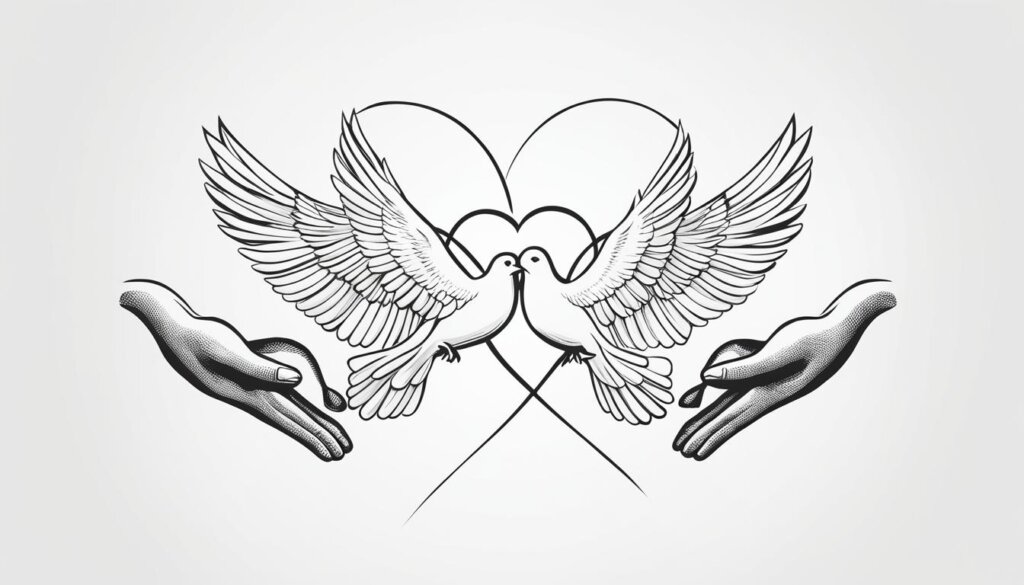Table of Contents
Symbols hold secret meanings that go beyond words. They are powerful tools for communication and cultural expression. Symbols serve various essential functions across different contexts, including communication, cultural expression, religious and spiritual significance, identification, navigation and information, emotional expression, and branding and marketing.
Symbols for Communication and Cultural Expression
Symbols have a remarkable ability to transcend language barriers, allowing for effective communication across cultures and communities. They serve as powerful tools for conveying complex ideas and concepts in a concise and visually engaging manner. Moreover, symbols play a crucial role in cultural expression, representing shared meanings and values within a community.
Artists, writers, and creators of various forms of expression often utilize symbols to evoke emotions, add depth, and enhance the overall communication of their ideas. By incorporating symbols into their work, they imbue their creations with layers of meaning that can resonate with audiences on a profound level.
“Symbols are like musical notes that form a language, enabling us to communicate beyond the limitations of words.”
Companies and organizations also recognize the power of symbols for communication and branding. Logos, for example, are visual symbols that serve as a representation of a company’s identity and values. Through consistent use, logos become recognizable, conveying the brand’s message and enhancing brand recognition in the minds of consumers.
Whether used in artistic expressions, cultural rituals, or marketing campaigns, symbols for communication and cultural expression hold a significant place in human society. They unite us, inspire us, and provide a means of understanding the world around us, transcending the boundaries of language and cultural differences.
The Impact of Symbols in Art and Literature
In art and literature, symbols serve as potent tools for conveying emotions and enriching the narrative. When an artist includes a symbol in their work, it invites viewers or readers to interpret the piece on a deeper level, adding layers of meaning that go beyond the surface.
For example, the sunflower, often depicted as a symbol of adoration and loyalty, holds different connotations depending on the context in which it is used. In Vincent van Gogh’s Sunflowers, the vibrant yellow blooms symbolize the artist’s hope and optimism. In literature, symbols like the white whale in Herman Melville’s Moby-Dick represent obsession and the overwhelming power of nature.
“In art and literature, symbols unlock hidden meanings, inviting us to explore the depths of human experience.”
By incorporating symbols into their work, artists and writers can engage their audiences on a profound level, stimulating thought and fostering a deeper connection between the creator and the consumer of the artwork or literature.
10 Common Symbols and their Meanings
There are numerous common symbols that are widely recognized and carry significant meanings. Understanding these symbols can provide insights into various aspects of life and culture. Here are ten common symbols and their meanings:
-
The Heart Symbol:
The heart symbol represents love, affection, and compassion. It is often associated with emotions, relationships, and matters of the heart. -
The Peace Symbol:
The peace symbol is a universal symbol of peace and harmony. It is often used to promote peaceful cooperation and anti-war movements. -
The Yin and Yang Symbol:
The yin and yang symbol represents the concept of balance and harmony. It depicts contrasting forces that complement and intertwine with each other. -
The Infinity Symbol:
The infinity symbol represents eternity and endless possibilities. It signifies the boundless nature of time, space, and existence. -
The Om Symbol:
The Om symbol is a sacred symbol in Hinduism and Buddhism. It represents the divine and spiritual sound, symbolizing the essence of the universe. -
The Anchor Symbol:
The anchor symbol is often associated with stability, hope, and security. It represents grounding and can symbolize strength during challenging times. -
The Tree of Life Symbol:
The tree of life symbolizes connection, growth, and the interdependence of all living beings. It represents the cycle of life and the unity of nature. -
The Eye of Horus Symbol:
The eye of Horus symbol holds significance in ancient Egyptian mythology. It represents protection, good health, and insight into the mysteries of life. -
The Lotus Flower Symbol:
The lotus flower is a powerful symbol of purity, enlightenment, and spiritual awakening. It represents the journey of overcoming challenges and attaining enlightenment. -
The Triquetra Symbol:
The triquetra symbol, also known as the Trinity Knot, is a symbol of the trinity and unity. It represents the interplay of three elements or forces in harmony.
These common symbols encompass a wealth of meaning and are often used to convey deep concepts and emotions. Exploring their symbolism can enhance our understanding of diverse cultures and inspire meaningful connections.
| Symbol | Meaning |
|---|---|
| The Heart Symbol | Love, affection, compassion |
| The Peace Symbol | Peace, harmony |
| The Yin and Yang Symbol | Balance, harmony |
| The Infinity Symbol | Eternity, endless possibilities |
| The Om Symbol | Spiritual sound, sacredness |
| The Anchor Symbol | Stability, hope |
| The Tree of Life Symbol | Connection, growth |
| The Eye of Horus Symbol | Protection, insight |
| The Lotus Flower Symbol | Purity, enlightenment |
| The Triquetra Symbol | Trinity, unity |
Universal Symbols for Meaning
Universal symbols are powerful tools of communication that transcend cultural and societal boundaries. They hold profound meanings that resonate with human aspirations and experiences. These symbols are widely recognized and understood across different cultures, making them an essential part of our shared language.
Circle: Wholeness and Unity
The circle is a universal symbol that represents wholeness and unity. It has no beginning or end, symbolizing eternal cycles, interconnectedness, and the continuity of life. The circle is often associated with concepts such as harmony, completeness, and perfection.
Cross: Spirituality and Sacrifice
The cross is a symbol that holds deep spiritual significance in various cultures and religions. It represents spirituality, sacrifice, and divine connection. The cross is synonymous with Christianity, where it symbolizes the crucifixion of Jesus Christ and the redemption of humanity.
Star: Guidance and Aspiration
The star is a symbol that guides and inspires. It signifies guidance, inspiration, and aspirations. Stars have been used throughout history for navigation and as celestial beings that guide us in our journey. In many cultures, stars are associated with hope, dreams, and the pursuit of greater things.
Spiral: Growth and Journey
The spiral is a symbol that represents growth, transformation, and continuous evolution. It is a dynamic symbol that reflects the cyclical nature of life and the journey towards self-discovery. Spirals can be found in nature, art, and ancient architecture, symbolizing the unfolding of life’s processes.
Sun: Life and Energy
The sun is a universal symbol of life, energy, and vitality. It is the ultimate source of light and warmth, essential for the sustenance of all living beings. The sun represents power, growth, and enlightenment. Across cultures, the sun is often associated with deities and gods, symbolizing their strength and life-giving properties.

“Symbols are the universal language that transcends words, allowing us to communicate, connect, and understand each other on a deeper level.”
Spiritual Symbols Meaning
Spiritual symbols hold deep significance in their respective traditions and are visual representations of profound concepts. These symbols have been used throughout history to convey powerful spiritual and philosophical ideas. They serve as a channel to connect with higher realms and express the mysteries of the universe.
One example of a spiritual symbol is the Ankh Cross, which represents life and regeneration. It is an ancient Egyptian symbol that blends the symbols of a cross and a loop, signifying the eternal cycle of life and death.
Another significant spiritual symbol is the Mandala, a geometric pattern that represents unity and balance. Mandalas are used in various spiritual practices, such as Buddhism and Hinduism, to aid meditation and promote spiritual growth.
The Dharma Wheel is a Buddhist symbol that represents the path to enlightenment. It consists of eight spokes that symbolize the Noble Eightfold Path, which leads to the cessation of suffering and the attainment of true wisdom.
The Hamsa Hand, also known as the Hand of Fatima, is a symbol of protection and strength. It is believed to bring blessings, ward off evil spirits, and bring good fortune to those who wear or display it.
Lastly, the Sri Yantra is a sacred geometric symbol representing spiritual and cosmic harmony. It is composed of intersecting triangles and is considered a powerful tool for meditation and manifestation.
These spiritual symbols hold deep meaning and offer guidance and inspiration to those who seek a deeper connection with their spirituality.
FAQ
What are symbols and why are they important?
Symbols are powerful tools for communication and cultural expression. They hold secret meanings that go beyond words and serve essential functions across various contexts, including communication, cultural expression, religious and spiritual significance, identification, navigation and information, emotional expression, and branding and marketing.
How do symbols contribute to communication?
Symbols transcend language barriers and efficiently convey complex ideas. They play a crucial role in cultural identity, representing shared meanings within a community. Symbols are used in art, literature, and other creative forms to evoke emotions and add depth to the expression of ideas.
How are symbols used in branding?
Companies use symbols like logos to create visual identities and promote brand recognition. These symbols are often carefully designed to convey the values and personality of a brand.
What are some common symbols and their meanings?
There are numerous common symbols with widely recognized meanings. Some examples include the heart symbol, representing love and affection; the peace symbol, representing peace and harmony; the yin and yang symbol, representing balance and harmony; the infinity symbol, representing eternity and endless possibilities; the Om symbol, representing spiritual sound and sacredness; the anchor symbol, representing stability and hope; the tree of life symbol, representing connection and growth; the eye of Horus symbol, representing protection and insight; the lotus flower symbol, representing purity and enlightenment; and the triquetra symbol, representing trinity and unity.
What are universal symbols?
Universal symbols are those that hold meaning across cultures and societies. They represent concepts and experiences that resonate with human aspirations. Some examples of universal symbols include the circle, representing wholeness and unity; the cross, representing spirituality and sacrifice; the star, representing guidance and aspiration; the spiral, representing growth and journey; and the sun, representing life and energy.
What is the significance of spiritual symbols?
Spiritual symbols hold deep significance in their respective traditions and are often visual representations of profound concepts. Examples include the Ankh Cross, representing life and regeneration; the Mandala, representing unity and balance; the Dharma Wheel, representing the path to enlightenment; the Hamsa Hand, representing protection and strength; and the Sri Yantra, representing spiritual and cosmic harmony.












